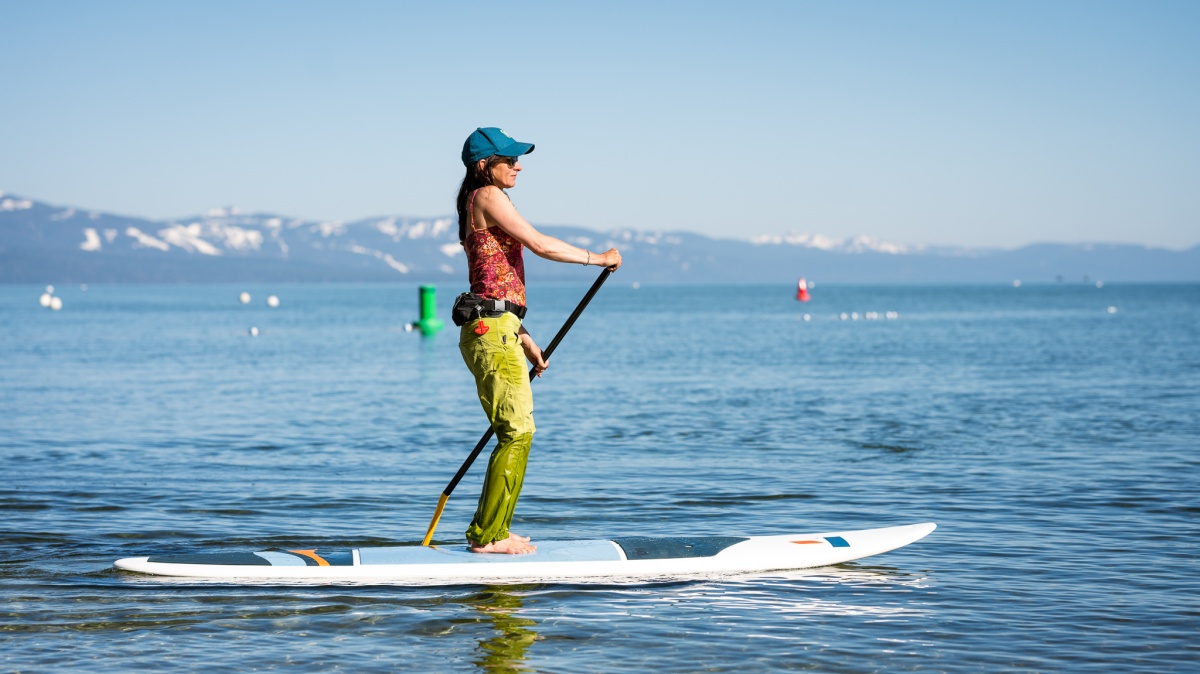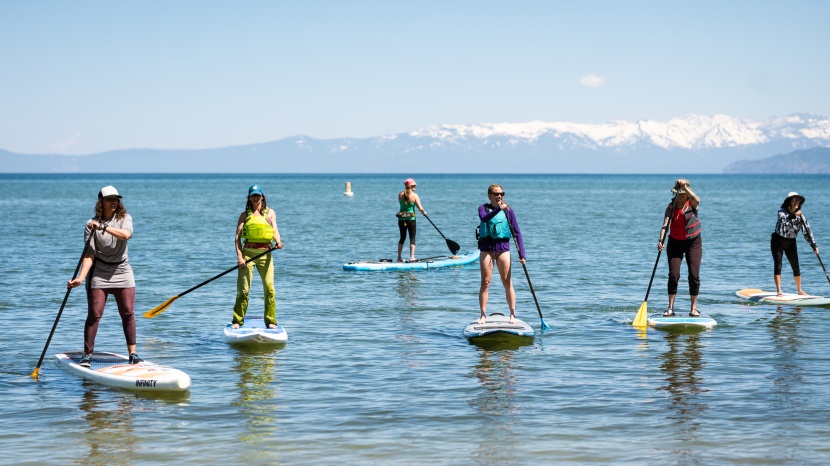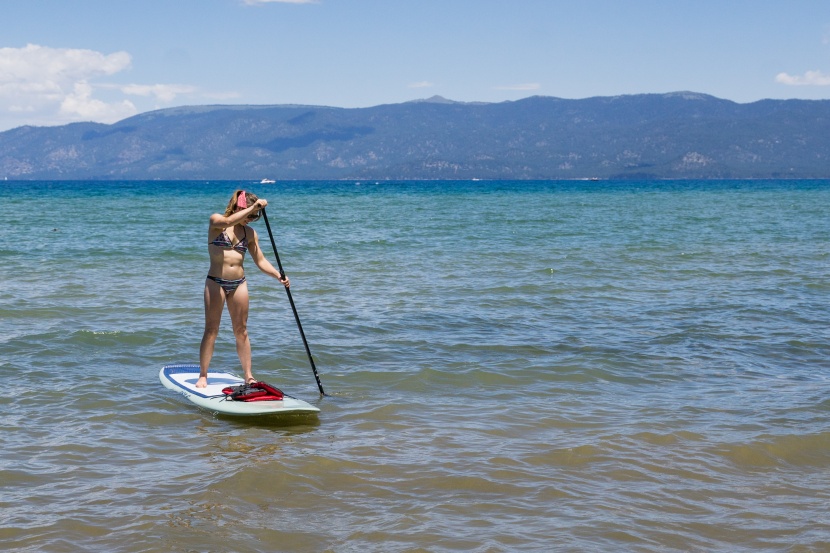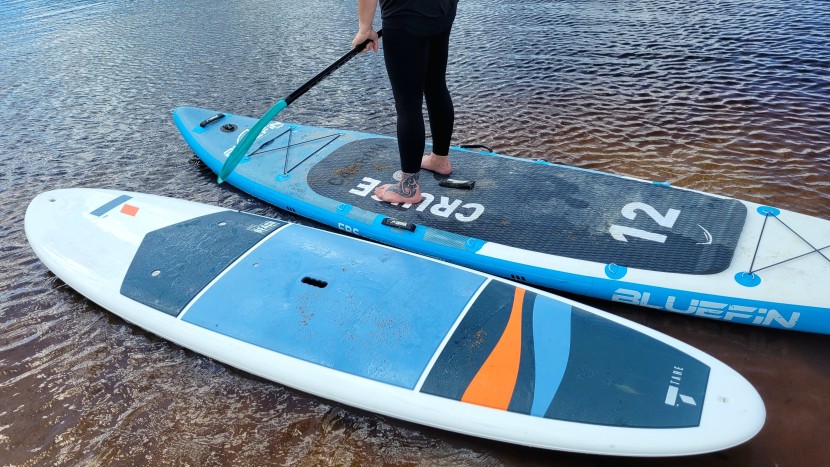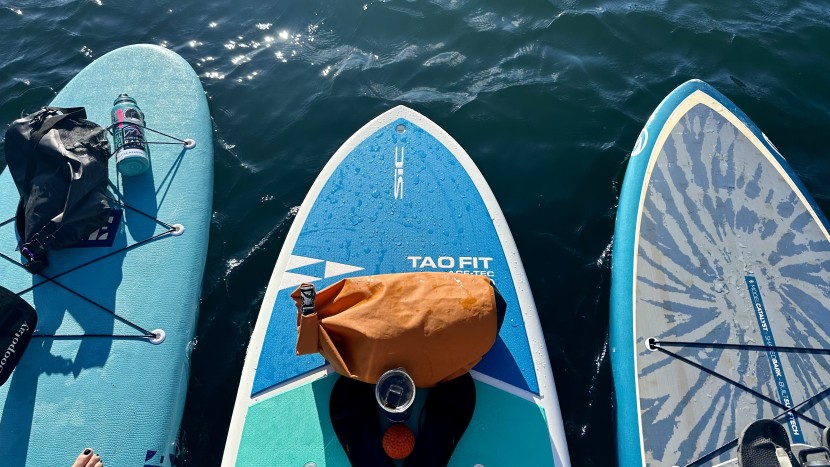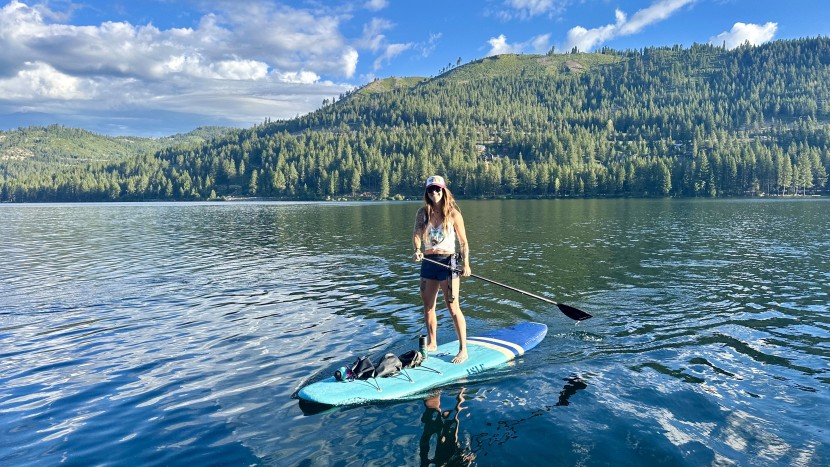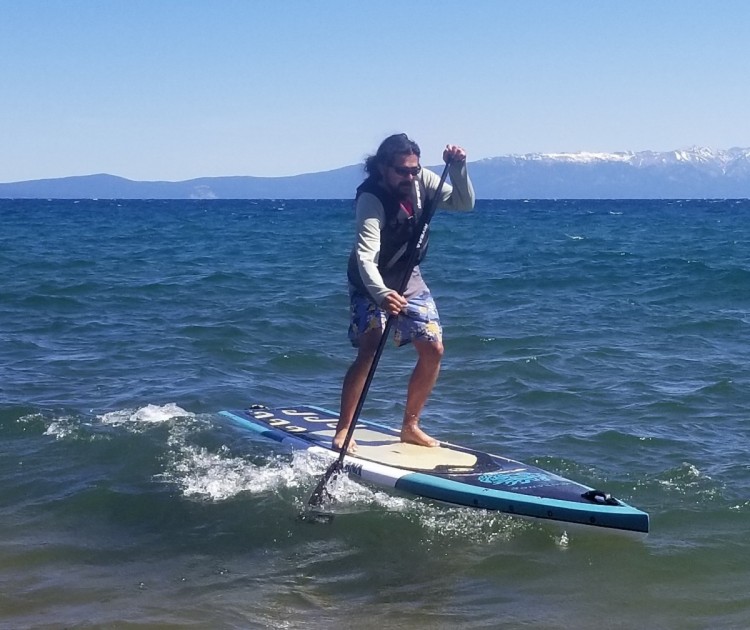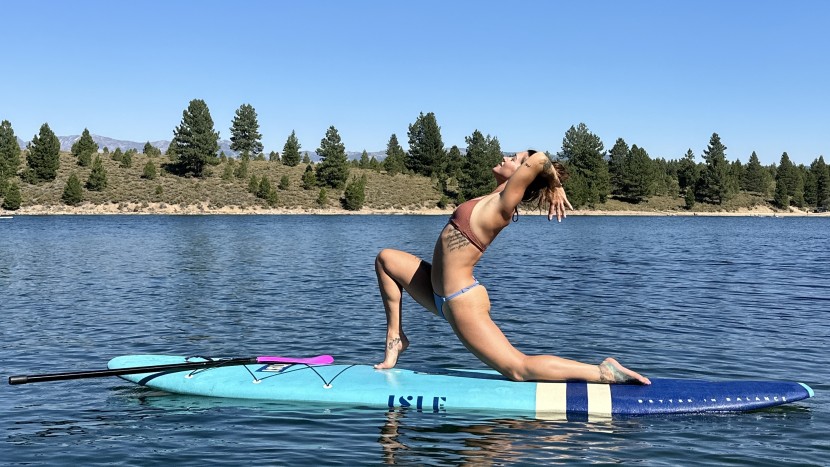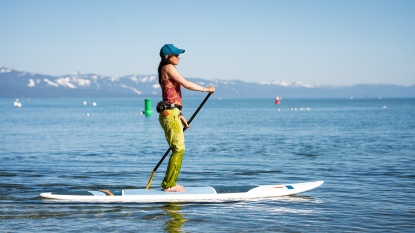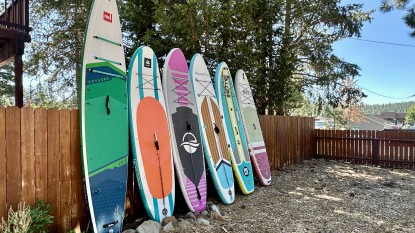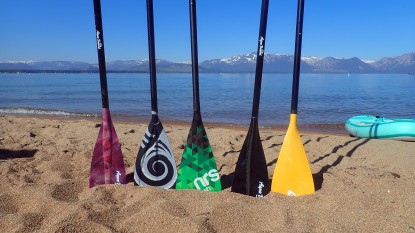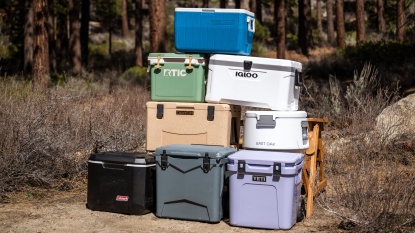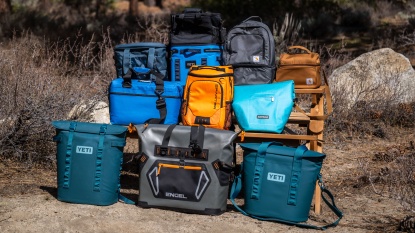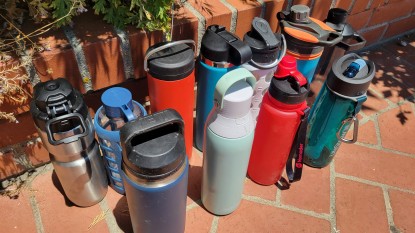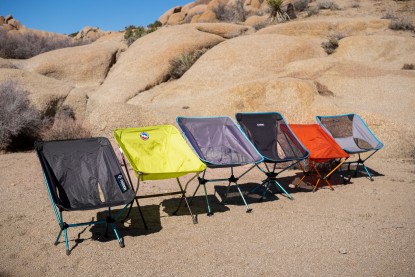Stand up paddle boards, or SUPs, have become a commonplace sight at just about every body of water you might visit, from local ponds to the ocean on calmer days. While they might look very similar, you actually have plenty of different choices to consider when shopping for your new paddle board. This article breaks down the different choices and what to look for, covering everything from rigid to inflatable to touring, racing, all-around, and surfing SUPs.
Why Buy A Stand Up Paddle Board? What Can You Do With It?
A SUP is a great way to get out and enjoy the water without a ton of work. These boards can usually be carried and launched by a single person, as well as transported by most cars. Many of the more beginner-friendly have practically zero learning curve and will have novice paddlers cruising around within an hour or so. Touring and race models have excellent glide performance, allowing you to travel surprisingly long distances, while some models are highly maneuverable, making them suitable for surfing or choppy water. SUPs are a great way to make the most of your day out on the lake or ocean.
However, these boards don't handle rough waters and high winds all that well, meaning that beginners should stick to flat waters and calm days when starting out and always wear a life jacket or other Personal Floatation Device (PFD). Speaking of PFDs, it's also a prudent idea to check local laws and regulations for your area to see which may apply to your new SUP. You may be obliged to wear or carry a PFD, light, or whistle and to avoid specific areas. Paddle boards do count as a vessel in most jurisdictions, so you are usually bound by the safety regulations relevant to boating. Now that you are set on getting a paddle board, it's time to narrow down the possible choices to the type that suits you best.
Step 1: Inflatable Or Rigid?
The first question that comes to mind when attempting to pick out a board is deciding between an inflatable or a rigid (also sometimes called hardshell) model. Both types have their advantages and disadvantages, and we will outline some of them for each board below.
Inflatable boards are usually lighter than their fiberglass or hard plastic counterparts and are generally more portable. These boards also tend to be more economical and are an excellent option for someone who doesn't have the room to store a full-size board at home or folks who lack the ability to transport one. These boards are much more portable, and many even come with backpack-style storage bags to make it easy to take on further adventures. They are usually more susceptible to damage than rigid SUPs, although they take some considerable force. The hulls can usually withstand minor scrapes and scuffs without issues.
Unfortunately, inflatable models do have some distinct disadvantages. There are generally more parts to keep track of, such as the pump or inflator and removable fins. Setup can take 10-20 minutes depending on how fast you pump your board up. The board's stability directly depends on getting it pumped up to the necessary pressure — a surprisingly difficult task. These boards are also generally slower and less stable than rigid models. However, you shouldn't take this as a condemnation of inflatable models. We have had fantastic days on both rigid and inflatable models. Check out our favorite inflatable SUPs if you are leaning in that direction.
Moving on to rigid models, there is no denying that these are more cumbersome to carry, as a 9 to 12-foot board tends to be more difficult to move than an inflatable model rolled up into a backpack. These boards are also a little more fragile, as small collisions or improper handling can crack or scratch away the gel coat, causing cracks and damage to propagate over time.
However, rigid SUP boards tend to outperform their inflatable counterparts once in the water. They're usually much faster and more stable. As this review is for rigid boards, we will continue under the assumption that you have settled on this model. If that isn't the case, then you will be better served by our inflatable SUP buying advice guide.
Step 2: Baffled By Board Type?
As you start shopping for rigid SUPs, you will notice several types of boards advertised, predominantly boiling down into three types: all-around, touring/race, and surfing. This is by no means a comprehensive list, and you can split these types into even more niche categories, but these three types are where most people will start looking.
Touring/Racing
SUPs designed for touring and racing are generally longer and much skinnier than the previous two types of boards, offering an unparalleled glide performance. Touring boards are slightly wider, giving you more stability, and are designed for endurance paddles, usually accounting for the fact that you will have some gear with you. Racing boards are slightly longer and narrower than touring board, sacrificing some stability for increased speed. While racing and touring boards are fast and track well, both types sacrifice stability and maneuverability when compared to an all-around board. These boards also tend to be pricey and aren't the best bet for beginner paddlers.
All-Around Boards
These boards are the jack-of-all-trades of the SUP world, usually wider, thicker, and larger than surfing models but shorter than racing or touring boards. A fantastic choice for beginning and intermediate paddlers, these boards do an alright job at pretty much everything. They have decent glide performance, track reasonably well, and have enough rocker to deal with choppier conditions.
These are good family boards, as you can usually carry a child, cooler, or canine companion without too much difficulty. These models also generally have a more palatable, mid-range price tag.
Surfing
Surfing boards are generally on the shorter and smaller side when compared to the all-around or touring boards. These have a design similar to a standard surfboard, simply scaled up. SUPs that are designed for surfing or lean toward surfing aren't the most stable and don't excel at glide performance, but they are very maneuverable. These models also have narrow rails to cut into the face of the wave.
Step 3: Just Starting Out? Carrying Cargo Or Yearning For Yoga?
Now that you have settled on the class of board that best suits your needs, it's time to look at what makes a board fit you. Every board will have a maximum weight capacity listed, but it's prudent to stay well below that. Beginners should look for a board with a displacement or maximum weight limit of about double your weight to ensure the most stable ride. Intermediate paddlers can get away with a displacement of about 170% of their weight, and advanced paddlers can even get as low as 130% of their weight. This usually translates to a longer board for a larger paddler.
In addition to your weight, it's important to consider what you will be carrying, who else will be on the board, or what you are planning on doing. Those looking to paddle with a child or canine companion should usually go for the wider board when picking between models, even if it is only by an inch or so—it can make a surprising difference, especially in choppy water. The same goes for those who are hoping to do yoga on the board. A wider surface not only offers more stability, but more room to play and stretch.
Conclusion
Hopefully, this article helped you on your journey to pick the perfect paddle board for your next excursion. For more info on how specific models stacked up, consult our comprehensive review on the best stand up paddle boards, or for more information on how we came to our conclusions, take a read through our How We Test article for a breakdown of our testing procedures and processes. Don't forget to take a look at our round-up of the best SUP paddles and top-rated PFDs.

